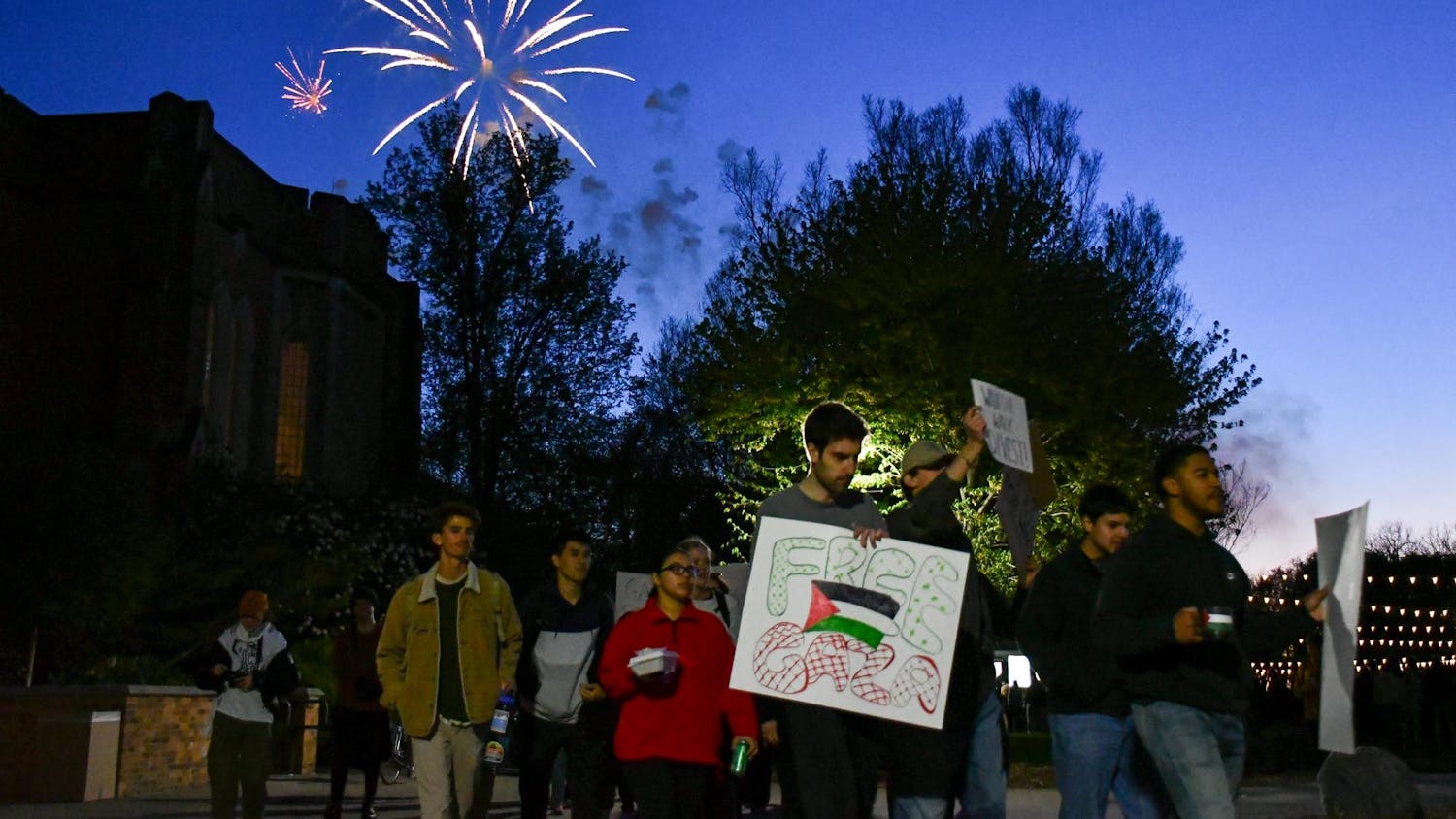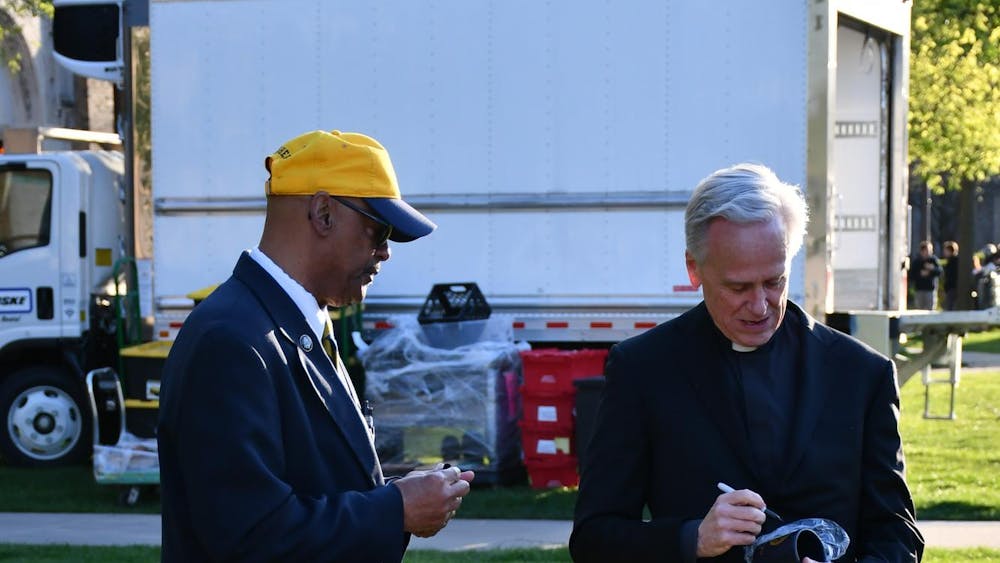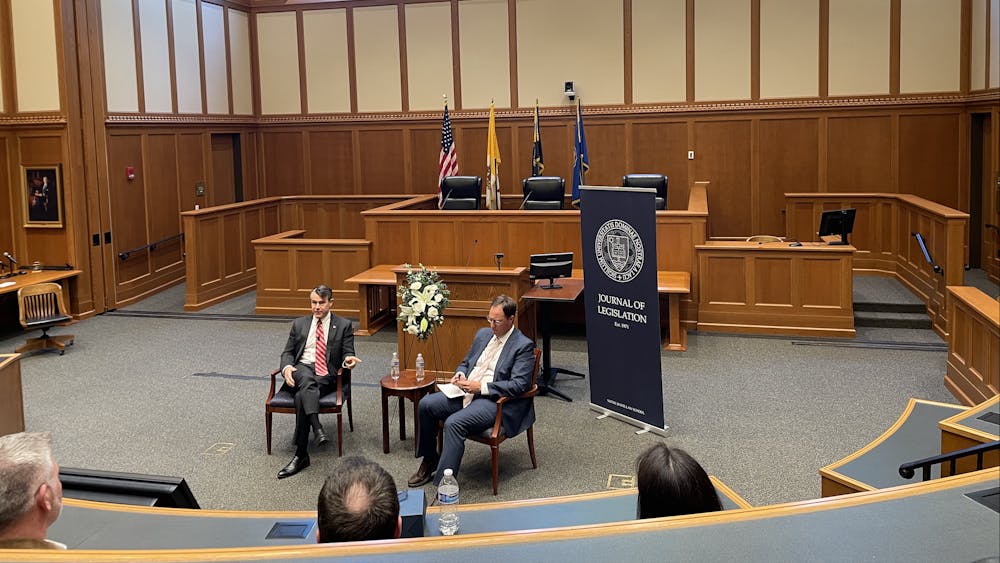A memorial service and Mass for Jim T. Butz, class of 1949, who worked in the Notre Dame Stadium press box for decades and was instrumental in the creation of the iconic Fighting Irish leprechaun logo, will take place at the Basilica of the Sacred Heart on Monday morning.
Butz, who died Oct. 12 at the age of 90, will be buried at Cedar Grove Cemetery on campus.
Butz was on the sports information department staff for the football team from 1947 to 1949 and returned to Notre Dame every home football game for 31 years to work in the press box as a stringer for United Press, Jim P. Butz, the son of Jim T. Butz, said. In the mid-1960s, the University planned to change its current mascot, an Irish terrier called Clashmore, but Jim P. Butz said his father, who worked at Wilson Sporting Goods at the time, immediately thought of Ted Drake, an illustrator for Wilson.
“Dad said, ‘I know exactly the guy you need to be working with,’” Jim P. Butz said. “He called on Ted and said, ‘can you create some symbol for Notre Dame, some example their Irish heritage that they want to exemplify?’ And [the leprechaun] was what Ted came up with.”
Jim T. Butz gave Drake’s drawing to the University, and in 1965, the leprechaun became the official mascot, Jim P. Butz said. Drake, who died in 1999, went on to design the logo for the Chicago Bulls.
“When you think of how many millions of people know that Fighting Irish logo – the vast majority of the people who are alive never knew the University had a different mascot,” Ric Jarrett, a friend of the Butz family, said. “They see the ND and Fighting Irish logo ... That one little tiny aspect of his life has touched a couple hundred million people.”
Jim T. Butz was devoted to Notre Dame and a lifelong fan, his son said. A native of Akron, Ohio, Jim T. Butz grew up listening to Irish football on the radio, and after high school he was drafted into World War II. Whenever he could find a typewriter, Jarrett said Butz would write a letter to Notre Dame’s dean of admissions and express his interest in attending the University.
“He would tell him he had survived this or survived that and wanted to go to school,” Jarrett said. “He did that the entire time he was gone.”
Jim P. Butz said after the war, his father had trouble getting into Notre Dame since all the soldiers who had been drafted while they attended Notre Dame had priority so they could finish their degrees. Jim T. Butz asked some friends to put in good words for him, and he caught the attention of Sports Information Director Charlie Callahan, who brought Butz’s case to then-University President John J. Cavanaugh.
“Fr. Cavanaugh called for his file, and all of the letters in the file were neatly typed, nothing handwritten,” Jim P. Butz said. “It was easy to read. Everything was documented. That’s when Cavanaugh said, if Fr. Sorin had not established Notre Dame for students such as this, who did he establish the University for? He asked how many beds they were already short, and he said, ‘We’re going to be short one more.’”
Before he even started as a student in 1946, Butz was hired by Callahan as a staff member, and Butz soon became a public-relations writer for athletic director and football coach Frank Leahy. For the three years Butz was a student, the football team never lost a game, and in 1947 the team won one of the four national championships under Leahy’s leadership. For all that time, Butz was “Leahy’s right-hand man; he was the one speaking for him,” Jim P. Butz said.
Jim T. Butz married in 1948, had the first of five children and graduated after three years. Afterwards, he moved to a Chicago suburb to raise his family and work for Wilson Sporting Goods’ marketing department. He continued to write, ghostwriting for sports greats such as bowler Joe Wilman and golfer Arnold Palmer, his son said.
Eventually Butz settled in the golf industry, running a variety of golf-related companies until he became acting executive director of the Professional Golfers Association (PGA), which took him to Palm Beach, Florida, his son said. He also lived in Los Angeles for a time before retiring in the Chicago area near his family. For the entire time he worked in Chicago, Butz returned to every Notre Dame game in a media capacity, and he was unfailingly courteous to fans of every team.
“My dad would make a point of greeting visitors from other schools and welcoming them from Notre Dame,” Jim P. Butz said. “He’d pull them over to our tailgate, wherever he found them."
Throughout his life, Jim T. Butz always remembered when somebody helped him succeed, his son said, whether Callahan, Leahy or a Belgian family. Jim P. Butz said when his father was behind enemy lines during the Battle of the Bulge in WWII, his squad hid for days in the basement of a house in Wye, Belgium. Years later, Jim T. Butz returned to Wye.
“He would bring blue jeans. He would bring candy bars to the family whose house they hid out in,” Jim P. Butz said. “He just wanted to thank them for having a house, for having someplace for him to hide. They didn’t really play any material role in his survival, but he just felt that burden of responsibility, that obligation to them. He felt that toward so many people in his lifetime, and he was always trying to repay favors to people who had helped him.”
Jarrett said Jim T. Butz’s was devoted to the University for his entire life and several of his children and grandchildren attended Notre Dame or Saint Mary’s.
“His family was first; his friends were second,” Jarrett said. “Anything and everything Notre Dame would have been right up there. He loved everything about the University. He loved his time there; he loved supporting the school. Having lived through WWII, in his mind it was … the ideal place to be. He loved it. He loved it in his 20s and he loved it in his 90s.”
Jarrett said Butz embodied the qualities of a Notre Dame graduate.
“If you were to roll up all the things which as an outsider you’d think of Notre Dame, that’s what he would be,” Jarrett said. “He was a kind man, smart, intelligent. He was a real people person. He got everything done … he lived the real deal.”













